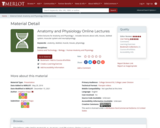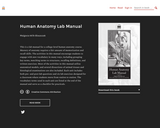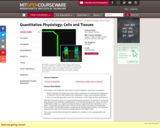
- Subject:
- Anatomy/Physiology
- Life Science
- Provider:
- Rice University
- Provider Set:
- OpenStax College


Online lectures for Anatomy and Physiology I. Includes lectures about cells, tissues, skeletal system, muscular system and neurophysiology.

This is a lab manual for a college-level human anatomy course. Mastery of anatomy requires a fair amount of memorization and recall skills. The activities in this manual encourage students to engage with new vocabulary in many ways, including grouping key terms, matching terms to structures, recalling definitions, and written exercises. Most of the activities in this manual utilize anatomical models, and several dissections of animal tissues and histological examinations are also included. Each unit includes both pre- and post-lab questions and six lab exercises designed for a classroom where students move from station to station. The vocabulary terms used in each unit are listed at the end of the manual and serve as a checklist for practicals.

Explores the interaction of radiation with matter at the microscopic level from both the theoretical and experimental viewpoints. Emphasis on radiation effects in biological systems. Topics include energy deposition by various types of radiation, including the creation and behavior of secondary radiations; the effects of radiation on cells and on DNA; and experimental techniques used to measure these radiation effects. Cavity theory, microdosimetry and methods used to simulate radiation track structure are reviewed. Examples of current literature used to relate theory, modeling, and experimental methods. Requires a term paper and presentation. The central theme of this course is the interaction of radiation with biological material. The course is intended to provide a broad understanding of how different types of radiation deposit energy, including the creation and behavior of secondary radiations; of how radiation affects cells and why the different types of radiation have very different biological effects. Topics will include: the effects of radiation on biological systems including DNA damage; in vitro cell survival models; and in vivo mammalian systems. The course covers radiation therapy, radiation syndromes in humans and carcinogenesis. Environmental radiation sources on earth and in space, and aspects of radiation protection are also discussed. Examples from the current literature will be used to supplement lecture material.

Principles of mass transport and electrical signal generation for biological membranes, cells, and tissues. Mass transport through membranes: diffusion, osmosis, chemically mediated, and active transport. Electric properties of cells: ion transport; equilibrium, resting, and action potentials. Kinetic and molecular properties of single voltage-gated ion channels. Laboratory and computer exercises illustrate the concepts. For juniors and seniors. Students engage in extensive written and oral communication exercises.